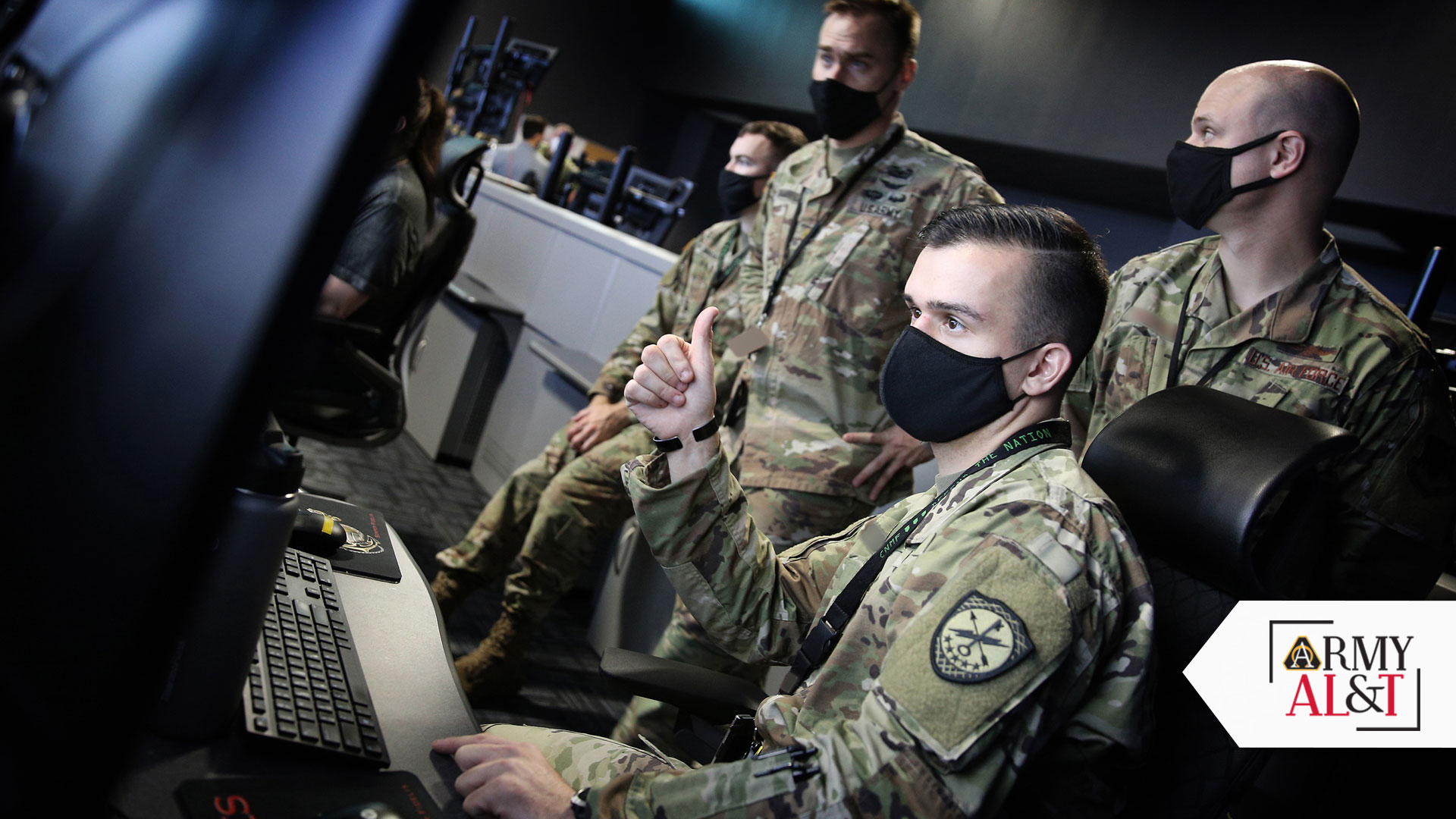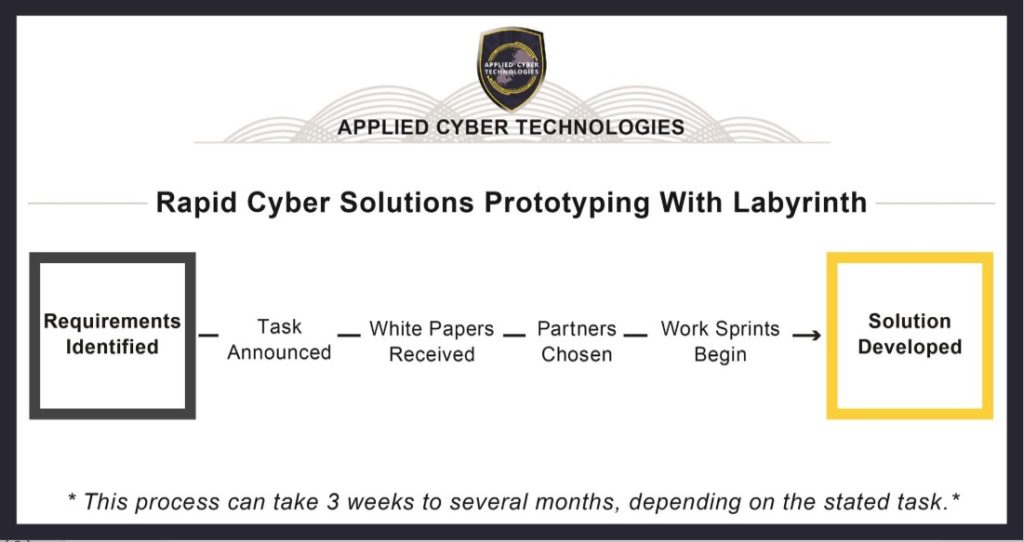
HIGH PRIORITY: Collaboration among the joint services is a top priority for U.S. Cyber Command. (Photo by Josef Cole, U.S. Cyber Command/DVIDS)
One small organization is changing the face of acquisition and collaboration, and taking cyber defense to a new level.
by Fianna Litvok
What happens when you combine superior technology, nontraditional acquisition and an award-winning solutions delivery model? A joint service collaboration that promises to take the nation’s cyber defense to a whole new level.
The U.S. Army’s Applied Cyber Technologies office is partnering with the U.S. Air Force Cryptologic and Cyber Systems Division to maximize capabilities within the DOD’s cyber enterprise. In November 2021, the organizations agreed to do a side-by-side performance comparison between their hardware and software, and determine if there was an interconnection.
Leaning forward with a top priority for the U.S. Cyber Command—joint collaboration—both organizations moved forward to affect change. Defensive Cyber Operations Applied Cyber Technologies (ACT) team began integration efforts with the Deployable Defensive Cyberspace Operations System – Modular and the Air Force’s version of the Defensive Cyberspace Operations Tools Suite, software tools designed to identify, mitigate and protect DOD networks from cyberspace threats. These teams will focus less on specific tools and more on the entire weapons system.

COLLECTIVE COORDINATION: U.S. Cyber Command personnel work to defend the nation in cyberspace at Fort George G. Meade, Maryland. Cyber Command’s mission is to direct, synchronize and coordinate cyberspace planning and operations—to defend and advance national interest—in collaboration with domestic and international partners. (Photo by Josef Cole, U.S. Cyber Command/DVIDS)
MAKING ACQUISITION WORK FOR US
The secret sauce lies in Labyrinth—Applied Cyber Technologies’ prototype solutions delivery mechanism. Labyrinth uses an other-transaction authority agreement to rapidly develop prototype solutions for the Army’s cyber enterprise. It also serves as the technical platform where prototypes are developed and assessed. Labyrinth has developed a partner ecosystem consisting of industry vendors and academia that integration teams can tap into whenever a critical challenge arises, or when a new solution is required.
When it became clear that the Army and Air Force wanted to explore technical synergies between their respective defensive cyber weapons, ACT turned to its partner ecosystem and sent out a request for information. A Labyrinth partner submitted a proposal indicating how they would approach the integration, which the government subsequently approved. Two months later, the vendor had successfully proved compatibility between the Army’s Deployable Defensive Cyberspace Operations System – Modular and the Air Force’s software, opening the door for further development. The nimble nature of the other-transaction authority consortium and Labyrinth’s Agile development methodology enable the Army’s cyber enterprise to move rapidly in a continually evolving landscape.
(For more on how the other-transaction consortium model works, see “Not Far at All,” in the Winter 2022 issue of Army AL&T.)
“Labyrinth provides our team with a key tool in our kitbag to quickly home in on solutions to some of our toughest acquisition challenges,” said Col. Mark Taylor, project manager for Defensive Cyber Operations at Army Program Executive Office Enterprise Information Systems.
Labyrinth is a straightforward yet novel mechanism. In many ways, it is an acquisition oddity; it breaks the proverbial mold of Army acquisition in its ability to quickly secure a prototype solution. Labyrinth’s strategic use of other-transaction authority, and its subsequent ability to rapidly respond to pressing challenges, helped it garner a 2021 Maj. Gen. Harold “Harry” Greene Award for Acquisition Writing in the innovation category.
“Developing novel ways of engaging with industry and rapidly securing prototypes are the best ways we can serve our cyber warriors,” said Arthur Edgeson, product lead for Applied Cyber Technologies. “We’re proud of our Labyrinth mechanism and what it allows us to do for our warriors.”

NOT LABYRINTHINE: Labyrinth is the Applied Cyber Technologies’ solution space where industry and government can collaborate to develop solutions, partnerships and more. (Graphic by Applied Cyber Technologies)
THINKING “DIFFERENTLY”
No one would argue about the importance of defense acquisition in keeping the nation safe. However, traditional acquisition models don’t necessarily provide rapid solutions. The novel emerging threats facing the nation today are a call to action for the acquisition workforce to consider new procurement approaches.
In recent years, DOD has made considerable efforts to quicken the pace of acquisition, particularly with the introduction of the Adaptive Acquisition Framework in 2020. Other-transaction vehicles serve as a promising possibility in the sometimes cumbersome acquisition framework. With Labyrinth, Applied Cyber Technologies has created a way to quickly equip the Army’s defensive cyber forces with effective prototype solutions while saving the government money on protracted development of full-fledged products that may not even work. Labyrinth is an Agile mechanism and does not require heavy lifting to implement. It supports creative collaboration with other organizations, and—in Applied Cyber Technologies’ case—with other services.
Other-transaction authority provides a way for organizations to create prototype solutions in a rapid and streamlined manner. These innovative vehicles can lead to successful prototypes that solve an immediate problem, while simultaneously paving the way for a more formal FAR-based acquisition down the road.
Other-transaction authority has been available to us for a long time. Because it can occasionally generate questions resulting from their unique nature, some organizations understandably are still cautious about using other-transaction authority when crafting an acquisition strategy. The vehicles are worth considering for their potential to help solve real-world problems. Other-transaction authority is “different” and requires organizations to think differently. In the end, thinking “differently” can make all the difference for our warriors.
CONCLUSION
Labyrinth stands out as an example of what is possible when organizations challenge their own assumptions.
Applied Cyber Technologies was established in 2018 to identify ways to rapidly provide solutions to the U.S. Army’s defensive cyber forces. Since its inception, the organization has known that Federal Acquisition Regulation-based vehicles would not suffice; it also has understood that other-transaction authority is suitably designed to provide the very solutions needed, even if only in prototype form. Applied Cyber Technologies’ Labyrinth and its use of other-transaction authority enable the rapid development of prototypes, as well as strategic collaborations like the project with the joint services.
It is possible that these innovations would have never come to pass had Applied Cyber Technologies held onto traditional ideas about what could or should be. Thinking differently leads to doing differently, and redefines concepts and new possibilities.
For more information, go to https://www.eis.army.mil/programs/act.
FIANNA LITVOK is the communications lead for Applied Cyber Technologies, and a two-time winner of the Maj. Gen Harold (“Harry”) Greene Award for Acquisition Writing. She also serves as a military intelligence chief warrant officer in the U.S. Army National Guard’s 91st Cyber Brigade. She holds an M.A. in English and B.A. degrees in English and in history from Stony Brook University.







